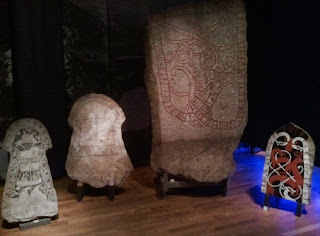Last weekend was all about frontiers – or at least boundaries or borders in the widest sense. The conference took place in Cambridge, but most of the subject matter was central Italian and related to the Frontiers of Etruria project Simon Stoddart is currently running. However, penultimate paper was about the afterlife of the Antonine Wall and what a rather splendid paper it was. It was fascinating to hear that after the withdrawal of the Romans behind the Hadrian Wall the use of Latin continued in the area between the walls even if the burial customs and such were similar across the whole Scotland mainland. Only later with the Christian church the Latin legacy reached other areas.
Not that the people knew what the humps and pumps running across to the narrowest stretch of land to the Forth to the Clyde was. It was just a general monument left by distant mythical creatures; only relatively recently archaeologists and historians could ascertain the character of the remains after the chance find of an inscription that mentioned the Emperor.
Most of the conference there were two sessions running on, so one could not hear or see everything. In addition, I and my husband were both presenting papers, so I spent some quality time with my son as well during the weekend. However, I managed to get my own goals covered and could ascertain that at least one of my research ideas is not covered by anybody else and the other will work to an extent. Only to an extent, since I was unaware how large field projects the Dutch team at Leiden is carrying out in the Apennines in order to study Latin colonies and their settlement patterns. Nevertheless, now I will able to streamline my own plan to a more realistic extent and do the core parts of my comparison of the Archaic and Late Republican occupation around Nepi.
The main result of the conference was that I seem to join the fine Finnish tradition of epigraphic research. Not that it is or was my primary aim, but the recently published studies make the epigraphic material an obvious choice when one wants to study cultural interaction in central Italy between the Archaic and Middle/Late Republican period. This relates to my promotion of the study of mental distances, e.g. relative closeness and distance between communities and groups in central Italy during the pre-Roman times. Now I have made the final touches to the article that presents this concept in its archaeological form to the reading academia; I think there is hope that the article and the volume it is part of will come out in the spring.
Nevertheless, some of the papers seem to support my suggestions. Frederik Tobin from Uppsala has found out that the tombs at San Giovenale presented architecture from both Tarquinia and Cerveteri. This suggest that either the tomb architecture is not as directly connected to the political power in the Etruscan past as it has been thought or that the communities in inner Etruria were not under strict rule of one of the large city-states on the coast, but could interact with and between them. Similarly, the material culture from the northern Faliscan area may suggest the same thing.




